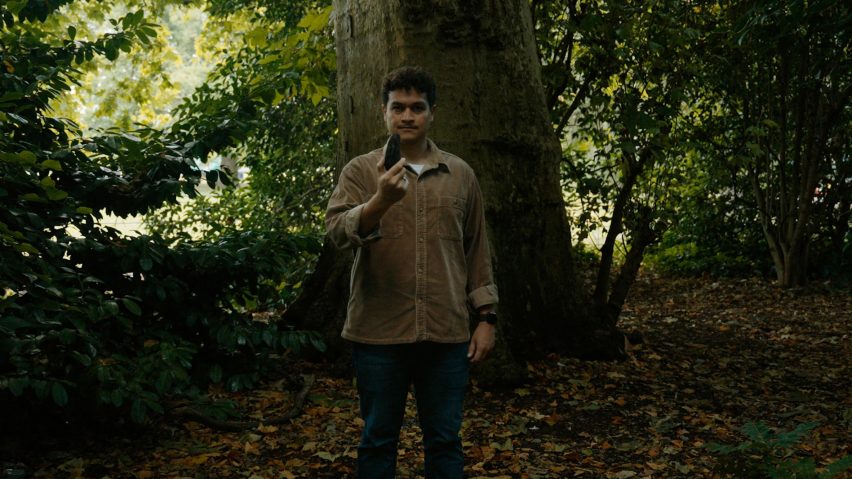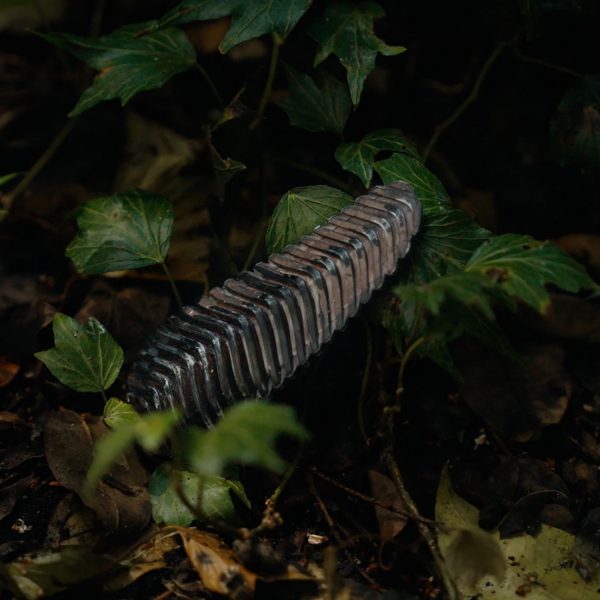A pinecone-shaped wildfire detector built out of wax and charcoal has won the UK James Dyson Award, recognising the best inventions by student and graduate designers.
Pyri was inspired by nature in its shape, materiality and also how it works. Its name references the botanical phenomenon known as “pyriscence”, wherein plants in wildfire-prone areas have adapted to release their seeds in high heat.
The shape of the device is based on pinecones from these kinds of trees, which drop their seeds only when their resin outer casing melts.
Similarly, the presence of fire liquefies Pyri’s wax shell, releasing a saltwater solution whose electrolytes activate the electronics contained within. This causes a radio frequency signal to be sent, alerting local communities to the danger.
The device constitutes an application of organic electronics – a field of materials science that uses carbon-based compounds instead of rare or precious metals to make electronics that are potentially biodegradable and avoid the need for mining.
Pyri is the product of four students from the Innovation Design Engineering graduate course at the Royal College of Art and Imperial College London: Richard Alexandre, Karina Gunadi, Blake Goodwyn and Tanghao Yu.

Alexandre is a Brazilian national, who was driven to create Pyri after witnessing the destruction caused by unprecedented wildfires in the country’s vast wetlands, the Pantanal, in 2020.
He said that Pyri was unique among wildfire alert solutions in not only using bio-inspired and bio-derived technology but also targeting remote communities without a lot of resources for forest protection.
“There genuinely are no similar ideas or concepts on the market to Pyri,” Alexandre told Dezeen.

“Unlike traditional methods, which rely heavily on sensors, cameras and satellites – often limited by coverage, accuracy and high costs – Pyri offers an effective, affordable solution suitable for extensive deployment, even in remote locations,” he added.
Pyri is low-cost, easy to install and requires zero maintenance, the designer said. It can even be deployed by helicopter drop to cover vast hectares of land within one day.
While Pyri’s final material composition is still under development, the key materials are wax and charcoal. The wax provides a trigger that removes the need for a traditional sensor, while carbon-rich charcoal serves as an electrical conductor.
“These materials were chosen for their abundance, effectiveness and non-toxicity to the environment compared to conventional materials like plastic and toxic metals like lithium and cobalt in batteries,” said Alexandre.
Once Pyri’s wax casing melts, it activates the power source, which triggers a radio frequency signal to be sent out via a simple signalling circuit and antenna made from a charcoal composite.
This can be picked up and triangulated from communication towers or receivers as far as tens of kilometres away.

Small amounts of metal are employed only where absolutely essential, using only types that are abundant and non-toxic such as aluminium.
If Pyri is never burned up, the device just sits in the environment as a foreign but non-toxic object, Alexandre said.
The design team has applied for a patent and tested each of the technologies individually but has yet to integrate all the components into one working prototype. Their next step will be to create this prototype and test it in a controlled fire environment.

Their win in the UK’s national leg of the James Dyson Awards gives them £5,000 to put towards further development. The team is also in the running for the £30,000 grand prize in the international competition, where they are up against the winners from 29 other countries.
Last year’s overall winner was the Golden Capsule – a non-powered, hands-free intravenous device designed for disaster zones by students from South Korea’s Hongik University.
Extreme wildfires such as those that hit the Pantanal are predicted to increase in frequency by 50 per cent by the end of the century, bringing with them huge volumes of carbon emissions.
Another wildfire detection system, ForestGuard, won the James Dyson Award in Turkey in 2023.

